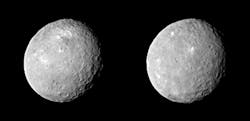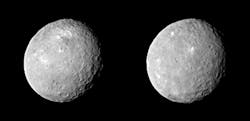Sharpest image yet of dwarf planet Ceres captured by NASA
NASA's Dawn spacecraft has captured images of the dwarf planet Ceres, which are the sharpest images captured of the planet to date. Dawn was launched in 2007 to study the asteroid Vesta and dwarf planet Ceres, celestial bodies believed to have formed early in the history of the solar system.
The instrument used to capture the images of the planet was Dawn's Framing Camera, which was designed by Germany's Max Planck Institute for Solar System Research (Göttingen, Germany; www.mps.mpg.de/en), to acquire detailed optical images. The camera uses a 20 mm aperture, f/7.9 refractive optical system with a focal length of 150mm and is based on a Thales Group (Neuilly-sur-Seine, France; www.thalesgroup.com) TH7888A CCD image sensor, a 1024 x 1024 sensor with a 14µm pixel size that can capture images at up to 30fps. The camera features a 5.5° x 5.5° field of view and an eight-position filter wheel permits panchromatic and spectrally selective imaging (7 narrow band filters).
Furthermore, the framing camera's broadest filter allows imaging at wavelengths ranging from 400-1050 nm. Because the camera is needed for both science and navigation, the payload has two identical but physically separate cameras (Framing Camera 1 and 2), each with its own optics, electronics, and structure.
Dawn previously explored the giant asteroid Vesta for 14 months during 2011 and 2012, allowing the scientists to gain numerous insights about the geological history of the asteroid. By comparing Vesta and Ceres, they will develop a better understanding of the formation of the solar system.

